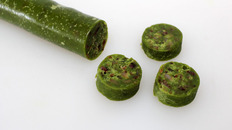zimmerstutzen
70 Cal.
- Joined
- Apr 2, 2009
- Messages
- 5,848
- Reaction score
- 1,215
When I was very young, I remember my grandmother, a very old school PA Dutch cook, making a raised bread that had all kinds of stuff in it. It was dark in color with molasses, a bit of cocoa, browned loose sausage crumbles, raisins, dried apples, oat meal and other things kneaded into the bread. It was baked into small loaves about 2 inches wide and 6 inches long. It was what she made when my grandfather and dad went hunting for several days.. I hadn't thought much about it, until I recently read a story about a dog sled race about 1910 and something similar was mentioned. I also read that early travelers in the Canadian Northwest carried a mixture of meat and beans with some sweetner that was cooked in advance and put into thin long cloth bags for trail meals. It could be eaten cold or heated on a fire. Rooster Cogburn had his bag of corn dodgers. The Indians had a mix of dried meat, dried berries and fat that they carried. Lewis and Clark took along a "portable soup" We assume frontiersmen carried dried meat jerky and some other foods. perhaps similar to what Indians used. However, I wonder whether there was a sort of energy bar food more like what my grandmother made.






